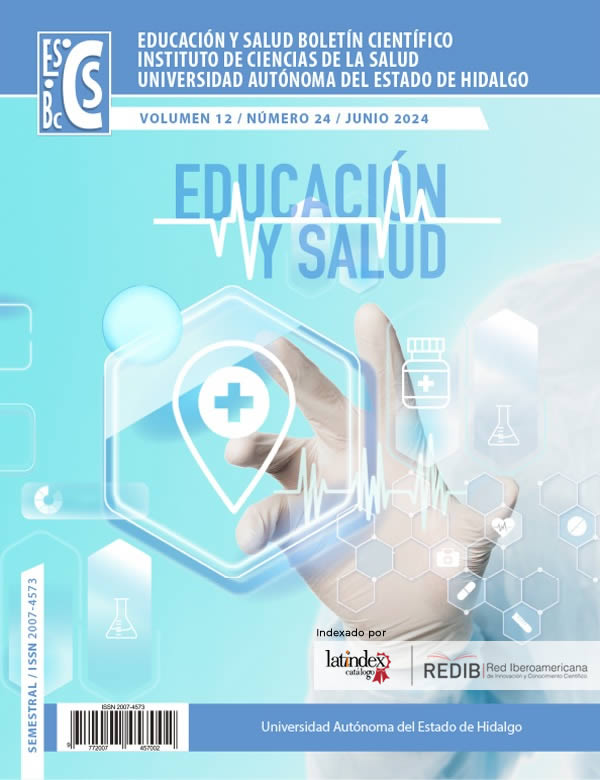Maladaptive daydreaming as a stress response in adolescents
DOI:
https://doi.org/10.29057/icsa.v12i24.12754Keywords:
Maladaptive daydreaming, adolescence, stressAbstract
Adolescence is a stage of changes in the subject, which are both physical and psychological. Also, at this stage a high level of stress is usually experienced due to the different challenges it offers, and therefore, young people can develop anxiety, depression, or other disorders. On the other hand, excessive daydreaming is a relatively new disorder, which consists of the creation of fantasy worlds, which affects the functioning in significant areas for the individual. The objective of this research is to expose the relationship between adolescence, stress, and excessive daydreaming. In conclusion, adolescents who experience a high level of stress can develop various conditions, including excessive daydreaming. Even so, there is some difficulty when it comes to intervening when this disorder is already present, since sometimes not enough attention is paid to it and it can be confused as a symptom of another disorder. In this way, it is important that adolescents look for strategies to deal with stress, such as mediation or going to psychological therapy.
Downloads
Publication Facts
Reviewer profiles N/A
Author statements
Indexed in
- Academic society
- N/A
References
Anniko, M. K., Boersma, K., & Tillfors, M. (2019). Sources of stress and worry in the development of stress-related mental health problems: A longitudinal investigation from early-to mid-adolescence. Anxiety, Stress, & Coping, 32(2), 155-167. https://doi.org/10.1080/10615806.2018.1549657
Bhargava, D., & Trivedi, H. (2018). A study of causes of stress and stress management among youth. IRA-International Journal of Management & Social Sciences, 11(03), 108-117. http://dx.doi.org/10.21013/jmss.v11.n3.p1
De la Iglesia, G., Solano, A., & Liporace, M. (2018). Perfiles de afrontamiento del estrés en adolescentes: su relación con la psicopatología. Revista de Psicología, 14 (27), 77-92. https://erevistas.uca.edu.ar/index.php/RPSI/article/view/1360/1285
Bigelsen, J., Lehrfeld, JM., Jopp, DS., Somer, E. (2016) Maladaptive daydreaming: evidence for an under-researched mental health disorder. Consciousness and Cognition, 42, 254-266. https://doi.org/10.1016/j.concog.2016.03.017
Espinoza, A., Guamán, M., & Sigüenza, W. (2018). Estilos de afrontamiento en adolescentes de colegios de la ciudad de Cuenca, Ecuador. Revista cubana de educación superior, 37(2), 45-62. http://scielo.sld.cu/scielo.php?script=sci_arttext&pid=S0257-43142018000200004&lng=es&nrm=iso&tlng=es
Figueroa, M., Contini, N., Betina Lacunza, A., Levín, M., & Estévez Suedan, A. (2005). Las estrategias de afrontamiento y su relación con el nivel de bienestar psicológico.Un estudio con adolescentes de nivel socioeconómico bajo de Tucumán (Argentina). Anales de Psicología, 21(1), 66-72. https://www.redalyc.org/articulo.oa?id=16721108
Hennis, A., Dover, S., & Hansen, M. (2022). The Role of Stress and Trauma in Immersive Daydreaming and Parasocial Relationships. https://digitalcommons.winthrop.edu/source/SOURCE_2022/allpresentationsandperformances/39/
Kessler, R., Angermeyer, M., Anthony, J., De Graaf, R., Demyttenaere, K., Gasquet, I., Kawakami, N. (2007). Lifetime prevalence and age-of-onset distributions of mental disorders in the World Health Organization’s World Mental Health Survey Initiative. World psychiatry, 6(3), 168. https://www.researchgate.net/publication/5663207_Lifetime_prevalence_and_age-of-onset_distributions_of_mental_disorders_in_the_WHO_World_Mental_Health_WMH_Surveys
Metin, B., Somer, E., Abu-Rayya, H. M., Schimmenti, A., & Göçmen, B. (2023). Perceived stress during the COVID-19 pandemic mediates the association between self-quarantine factors and psychological characteristics and elevated maladaptive daydreaming. International Journal of Mental Health and Addiction, 21(3), 1570-1582. https://doi.org/10.1007/s11469-021-00678-w
Midgley, N., Capella, C., Goodman, G., Lis, A., Noom, M., Tishby, O., & Weitkamp, K. (2018). Introduction to the special section on child and adolescent psychotherapy research. Psychotherapy Research, 28(1), 1-2. http://dx.doi.org/10.1080/10503307.2017.1380864
Musetti, A., Soffer-Dudek, N., Imperato, C., Schimmenti, A., & Franceschini, C. (2023). Longitudinal associations between maladaptive daydreaming and psychological distress during the COVID-19 health crisis. Journal of Behavioral Addictions, 12(1), 288-294. https://doi.org/10.1556%2F2006.2023.00001
Pietkiewicz, I., Nęcki, S., Bańbura, A., & Tomalski, R. (2018). Maladaptive daydreaming as a new form of behavioral addiction. Journal of Behavioral Addictions, 7(3), 838–843. https://doi.org/10.1556%2F2006.7.2018.95
Rivera, S., de la Vega Rodríguez, I., Villamor, M., Díaz-Marsa, M., & Perera, J. (2020). Trastorno de ensoñación excesiva: características clínicas y neuropsicológicas del primer caso descrito en España. Revista de Casos Clínicos en Salud Mental, 8(1), 2. https://dialnet.unirioja.es/servlet/articulo?codigo=7847212
Ross, C., Ridgway, J., & George, N. (2020). Maladaptive daydreaming, dissociation, and the dissociative disorders. Psychiatric Research and Clinical Practice, 2(2), 53-61. https://doi.org/10.1176%2Fappi.prcp.20190050
Schimmenti, A., Somer, E., & Regis, M. (2019). Maladaptive daydreaming: Towards a nosological definition. Annales Médico-psychologiques, 177 (9), 865-874. https://psycnet.apa.org/doi/10.1016/j.amp.2019.08.014
Shafiq, S., & Zafar, H. (2022). Social Anxiety as Predictor of Depression in Adolescents: Mediating Role of Dysfunctional Daydreaming. Journal of Liaquat University of Medical & Health Sciences, 21(04), 301-305. https://www.lumhs.edu.pk/jlumhs/Online-First/nov222.pdf
Sharma, P., & Mahapatra, A. (2021). Phenomenological analysis of maladaptive daydreaming as a new form of behavioral addiction: A case series. Indian Journal of Social Psychiatry, 37(3), 280-282. http://dx.doi.org/10.4103/ijsp.ijsp_227_21
Somer, E., Lehrfeld, J., Bigelsen, J., Jopp, D. (2016) Development and validation of the Maladaptive Daydreaming Scale (MDS). Consciousness and Cognition, 39, 77-91. https://doi.org/10.1016/j.concog.2015.12.001
Somer, E., Soffer-Dudek, N., Ross, C., & Halpern, N. (2017). Maladaptive daydreaming: Proposed diagnostic criteria and their assessment with a structured clinical interview. Psychology of Consciousness: Theory, Research, and Practice, 4(2), 176. http://dx.doi.org/10.1037/cns000011
Somer, E., Soffer-Dudek, N. y Ross, C. (2017). The Comorbidity of Daydreaming Disorder (Maladaptive Daydreaming). The Journal of Nervous and Mental Disease, 205(7), 525-530. https://doi.org/10.1097/nmd.0000000000000685
Somer, E. (2018). Maladaptive daydreaming: Ontological analysis, treatment rationale; a pilot case report. Frontiers in the Psychotherapy of Trauma and Dissociation, 1(2), 1-22. http://dx.doi.org/10.XXXX/ftpd.2017.0006
Soffer-Dudek, N., & Theodor-Katz, N. (2022). Maladaptive daydreaming: Epidemiological data on a newly identified syndrome. Frontiers in Psychiatry, 13. https://doi.org/10.3389/fpsyt.2022.871041
Vieco-Gómez, G., & Abello-Llanos, R. (2014). Factores psicosociales de origen laboral, estrés y morbilidad en el mundo. Psicología desde el Caribe, 31(2), 354-385. http://www.scielo.org.co/scielo.php?script=sci_arttext&pid=S0123-417X2014000200009&lng=en&nrm=iso&tlng=es
Zhang, Y., Zhang, X., Zhang, L., & Guo, C. (2019). Executive function and resilience as mediators of adolescents’ perceived stressful life events and school adjustment. Frontiers in psychology, 10, 446. https://doi.org/10.3389%2Ffpsyg.2019.00446
Zahn-Waxler, C., Shirtcliff, E., & Marceau, K. (2008). Disorders of Childhood and Adolescence: Gender and psychopathology. Annual Review of Clinical Psychology, 4, 275–303. https://doi.org/10.1146/annurev.clinpsy.3.022806.091358



















